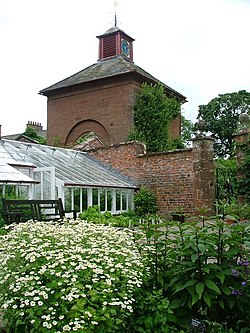Acorn Bank
| Acorn Bank | |
|
National Trust | |
|---|---|
 The Herb Garden and Dovecote at Acorn Bank | |
| Grid reference: | NY618281 |
| Location: | 54°38’49"N, 2°35’36"W |
| Information | |
| Website: | Acorn Bank |
Acorn Bank is a National Trust house and garden along the south bank of the Crowdundle Beck, just north of Temple Sowerby in Westmorland. Within the garden is a watermill on the beck, and so the property is introduced to visitors as 'Acorn Bank Garden and Watermill'.
The estate covers 180 acres of garden, park and woodland.
There is partial access to the house – a fine, sandstone house until recently let to the Sue Ryder Trust and now undergoing restoration.
Gardens
The Crowdundle Beck marks the border of Westmorland to the south with Cumberland to the north. The nearest village is Temple Sowerby and the nearest town is Penrith in Cumberland just six miles to the west.
The garden is noted for its collection of herbs: it grows over 250 medicinal and culinary herbs. It also has extensive orchards with old varieties of British fruit.
The garden is surrounded, and protected, by ancient oaks and high walls.
The watermill in the stream is partially restored.
History

The manor of Temple Sowerby was held by the Knights Templar until the order was suppressed in 1323, after which it passed to the Knights Hospitaller until they in turn were dissolved by King Henry VIII. In 1543 then, Acorn Bank was acquired by Thomas Dalston, a local landowner from Dalston, Cumberland, whose descendants owned the manor until the 1930s, passing a few times through the female line.
The house was built in the 16th century, of which parts remain, but the main block was rebuilt in the mid-17th century. In the 1690s and new frontage was built, and further modernisation came in the Georgian period.
The Boazman family of Newton Aycliffe came into ownership through marriage but left the house largely as they found it as it was not to be their main home.
In 1934, Acorn Bank and its estate were sold to Capt. Noel McGrigor Phillips and his wife Dorothy, who as Dorothy Una Ratcliffe was known as a writer, traveller and art collector. In 1950 she gave the estate to the National Trust.[1]

The Trust granted leases of the house until 2012, and set about developing the gardens to the display that they bear today.
Outside links
| ("Wikimedia Commons" has material about Acorn Bank) |
- Acorn Bank information at the National Trust
References
- ↑ The History of Acorn Bank: National Trust
- National Heritage List 1265726: Acorn Bank Mill
